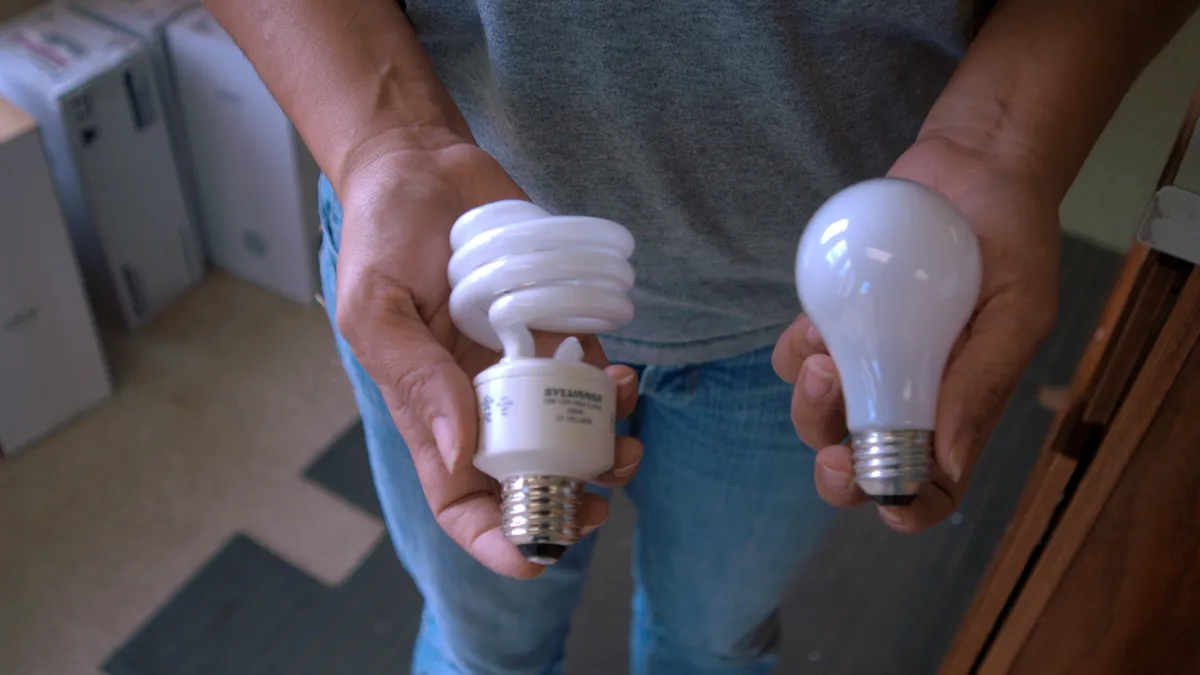Dive Brief:
-
The U.S. Department of Energy has made a final determination to reject more stringent efficiency standards for the commonly-used, pear-shaped incandescent lightbulbs, according to a Dec. 20 announcement from the Trump administration.
-
The DOE claims that the standards, supported by the Obama administration, would have forced consumers to buy replacement bulbs that are 300% more expensive. But that cost comparison excludes the much more efficient LED bulbs that would likely replace most incandescent bulbs, as pointed out by environmental groups that oppose the DOE move. Allowing incandescent lightbulbs to remain in the marketplace will impose billions of dollars of costs on consumers in the form of higher electricity bills, the groups said.
-
The Natural Resources Defense Council (NRDC) expects that courts will decide in favor of LEDs and order a phase out incandescent and halogen bulbs, despite the DOE's decision. Several states, such as California, are already moving ahead with the standards the DOE has rejected.
Dive Insight:
The proposal, now finalized by the Trump administration, argued that an efficiency standard of 45 lumens per watt for "general service incandescent lamps," the pear-shaped incandescents, was not economically justified, contrary to the Obama administration, which had supported the new standard. In a related move, the DOE has also decided against expanding the definition of bulbs that would have to meet higher efficiency standards to include other widely-used bulbs like the three-way, flame- or candle-shaped, and globe-shaped bulbs used in bathroom vanities.
Those two actions affect lighting used in 6 billion sockets around the country, and the lack of more stringent standards will lead to an extra $14 billion through 2025 spent on powering the less efficient bulbs with the equivalent of the output of 30 large power plants every year, according to a statement from NRDC.
In the DOE’s statement, however, Secretary of Energy Dan Brouillette said "the Trump Administration chose to protect consumer choice by ensuring that the American people do not pay the price for unnecessary overregulation from the federal government."
The more stringent standards would have increased the price of general service incandescent lamps by 300%, according to DOE's analysis. "This increase is not economically justified because the bulbs do not last long enough for the energy savings to surpass the higher upfront price," the statement said.
But in its final rule, the DOE said that its economic analysis did not include LED or CFL bulbs and that those substitute bulbs are "out-of-scope." The 300% price increase is based on comparing today’s incandescent bulbs to more efficient incandescents that would meet the 45 lumens per watt standard.
From the point of view of opponents, the DOE has essentially rigged the analysis in favor of keeping current standards. The agency "did the wrong analysis," NRDC Center for Energy Efficiency Standards Director Noah Horowitz said in an email to Utility Dive. "They should be comparing today’s incandescent with the substitute LED bulb that gives off the same amount of light."
LEDs are more expensive than equivalent incandescents in terms of upfront costs, but not nearly 300% more expensive. For example, Home Depot sells a 16-pack of 60-watt equivalent incandescent bulbs for about $1.03 each, while an 8-pack of 60-watt equivalent LEDs costs $1.35 per bulb. "We’d be happy to take DOE’s lawyers to Home Depot and other stores so they can see the shelves full of low cost LED light bulbs that use at least 4 times less energy than today’s incandescent bulbs and save consumers lots of money," Horowitz said.
In November, the attorneys general of 16 states and environmental groups, including NRDC, sued the DOE for withdrawing the Obama-proposed expansion of lightbulb standards. NRDC expects the courts to order the DOE to enforce the 45 lumens per watt standard "resulting in the end of future sales of inefficient incandescent and halogen bulbs," according to Horowitz.
The National Electrical Manufacturers Association (NEMA), which represents lighting system manufacturers, has defended the Trump administration’s decisions on lightbulb standards, arguing that the energy savings cited by opponents are exaggerated and that the marketplace will move toward more efficient bulbs without additional federal regulations. NEMA did not respond to a request for comment on the Dec. 20 final determination.













